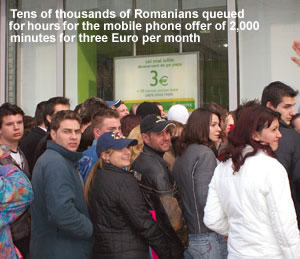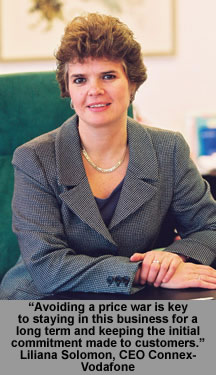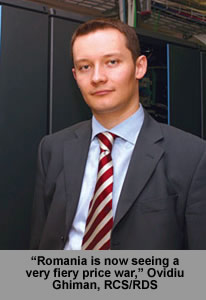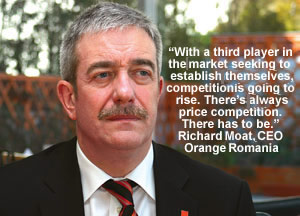Call to arms
New operators in the mobile and landline market will shake up the costs of calls as operators battle over services to the consumer. Does this mean there will be blood on the handset?
 On a cold March afternoon, hundreds
of people, mostly young, are staying out
in the snow and sleet outside a mobile
phone shop.
On a cold March afternoon, hundreds
of people, mostly young, are staying out
in the snow and sleet outside a mobile
phone shop.
They are facing the chill for hours.
Why?
“Are you kidding me?” says 18-yearold
Alex, a pupil at a near-by high school.
“I skipped school today and have been
waiting for about two hours to get the
chance to buy a card. If I queue up here,
I can talk for ages on my mobile for free.
I’m not sorry at all.”
This phenomenon was due to phone
operator Cosmote Romania’s offer of
2,000 monthly minutes for just three
Euro. Part of the Greek operator’s
aggressive strategy to break the duopoly
of Connex-Vodafone and Orange, the
campaign saw consumers bunk school
and work to line up in their thousands in
snow, rain and freezing temperatures to
pick up a SIM card so they could talk at
a cheaper rate on their phone.
|
||
Getting the young, in particular, to buy into a product has always been a strong marketing ploy and Cosmote’s strategy seems to have worked, with early rumours indicating that as many of 500,000 or more were sold in the first week of the 21-day campaign.
Standing the queue, 18 year-old Manuela says: “The bad thing is that you can only buy two cards per person, hence the queues. I tried to buy some cards for my friends as well, but I couldn’t, so they have to come and stand in line for themselves.”
Many already have a phone and SIM card.
“I have a Connex card, which I don’t intend to get rid of,” says 17-year-old Dan, who is also skipping school to line up for a Cosmote card. “I can still use that to call some of my friends who don’t have one of these new cards.”
Ileana, also an 18-year-old student, says she intends to throw the Cosmote card once the year expires.
“This is an offer which is good just for one year and these queues are like this because you have to buy and activate a card by the end of the month,” she says.
“I don’t know what will happen after that.”
RAISING THE STAKES
At the moment there are three major
phone operators in Romania.
In mobile telephony, Connex-
Vodafone and Orange have 6.2
million and seven million users
respectively, while in landline
Romtelecom is the clear market
leader. But alternative operators
are battling for the market
with packages of offers and
new services.
Together with Cosmote,
European giant Deutsche
Telekom has, through its
Hungarian landline company
Magyar Telecom, seized its
first chance on the Romanian
market. The Eufonica service, launched
by Romanian subsidiary Combridge, is
a carrier selection service, which piggybacks
on Romtelecom’s infrastructure
and aims to slash national calls by 20
per cent.
In both this and Cosmote’s cases, consumers
are only likely to switch their
landline to a new operator or carrier if,
knowing that they can get through to the
other line easily, the cost of calls will be
less.
So with big
name operators
entering the
market - are we
about to witness
a price war?
“Romania
is now seeing
a very fiery
price war,”
says Ovidiu
Ghiman, commercial
director
of RCS/RDS, a
cable TV operator
which offers
landline telephony. “The price is a very
important element when we talk about
services for the residential segment of
clients.”
Rumours on the market claim Cosmote
sold 500,000 pre-paid cards in the first
week. In the three weeks the offer lasted
this could have comfortably risen to
above one million. Officials at Cosmote
did not confirm this figure as we went
to press.
But the existing mobile phone operators
are circumspect about a price war.
“There has always been fierce competition
between us and Connex-Vodafone
even before Cosmote was re-launched,”
says Richard Moat, CEO of Orange
Romania. “If we look at the price of a
minute’s call over the last few years
there has been a substantial effective
reduction in that cost. So that level of
competition is not simply because of
the advent of Cosmote. But with a third
player in the market seeking to establish
themselves, competition is going to rise.
There’s always price competition. There
has to be.”
 A price war could be bad for business,
argues Liliana Solomon, CEO of
A price war could be bad for business,
argues Liliana Solomon, CEO of
Connex-Vodafone.
“Romania is experiencing some of
the lowest tariffs in Europe,” she says, “so avoiding a price war is key to staying
in this business for a long term and
keeping the initial commitment made to
customers.”
Prices are a major incentive, but services
are also important.
“I wouldn’t say we are seeing a price
war, because I believe this war is fought
more at the service quality level,” says Dinu Malacopol B2B director at cable
TV company UPC/Astral, which also
offers landline telephony. “It doesn’t
matter how small the prices from a
certain operator are if the quality of the
service is lacking.”
So the competition in services will
have to step up. Something mobile
operators continue to undertake.
“In the long term our research has
shown that Romanian consumers are
discerning and are interested in quality
rather than simply quantity or price,”
says Moat.
Solomon says her firm has a strategy
of offering increased value to both its
prepaid and post-paid customers through
exclusive propositions and continuously
adding benefits to reward the loyalty and
usage. New services for this year include
Vodafone Live!, Vodafone Passport and
Vodafone Simply.
Orange also has bundles of offers,
such as discounts for calls to favourite
numbers and flexible tariffs for business
and individuals.
So does this mean there will not be a
battle over who can maintain prices at
one cent per minute, but one on packages – a bundle war?
“Quite possibly – it all comes down to
the effective cost of the call,” says Moat.
“But offers like this are something new
and provide better value for money.”
LANDLINE BATTLE
Competing on price with the monopoly
of Romtelecom is hard. Especially
when, after 8pm, Romtelecom charges
one Eurocent per minute for all calls on
its own network.
A figure near-impossible for competitors
to undercut. “As an alternative operator,” Malacopol
says, “trying to beat the market leader at
better costs is unreal, as one cannot better
their special offers without losing.”
Instead these companies need to offer
new services and multimedia packages.
But Malacopol says none of the alternative
[landline] operators have been
that aggressive so far.
“On the corporate segment, though,
Romtelecom has stronger competition
from alternative and mobile operators,”
Ghiman says.
But the individual consumer or family
is less likely to switch from Romtelecom,
which means alternative landline operators
are now focusing on homeowners
rather than businesses.
“In this case the inertia is bigger,” says
Ghiman. “One needs to come up with
interesting offers to attract the consumer
who does not spend a lot of money on
telephone services to
switch their landline
provider.”
 Last year RCS/RDS
signed up more than
350,000 clients, which
is more than ten per
cent of Romtelecom’s
client base, added
to 100,000 Internet
clients.
Last year RCS/RDS
signed up more than
350,000 clients, which
is more than ten per
cent of Romtelecom’s
client base, added
to 100,000 Internet
clients.
“For this year we
target a doubling of the
number of clients, to
700,000, which actually
means a very good
percentage of the main
landline operator’s clients,”
says Ghiman.
Meanwhile Astral Telecom caters for
about 1.4 million subscribers, which
Malacopol says puts it first among local
alternative operators.
But to ask clients to migrate is not
easy.
“Changing your service provider
means changing your phone number,”
Ghiman says. “This is why when we
launched into landline telephony we
launched it very aggressively with very
attractive offers. At the same time we
launched a few very aggressive service
packages.”
Forcing someone to change their number
can be a problem.
This is partly why new mobile operators
seem to be targeting the young: their
flexibility.
They are more willing to change their
phone number or hold two or three
numbers, SIM cards for as many different
operators they may
have, or groups of friends,
or families, colleagues or
girl- and boyfriends.
However, at this moment,
the two main mobile phone
operators do not appear to
have any data to show how
many consumers have
more than one mobile
phone SIM card or how
many of the 14 million
mobile phone customers
are overlapping.
“There is some element
of duplication,” Moat says.
“I’d be guessing at how
large it is. It might be five
per cent.”
LONG-TERM VIEW
Cosmote’s approach of targeting the
pre-pay market mirrors the demands of
the majority of Romanian consumers.
Connex-Vodafone now has a customer
base of around 6.2 million, from which
post-paid clients account for 36 per cent,
an increase of two per cent on 2004.
 This is roughly the same for Orange,
although the company says the proportions
have remained stable.
This is roughly the same for Orange,
although the company says the proportions
have remained stable.
The mobile market has grown massively
over the last five years. This makes
some observers believe the bubble will
soon burst.
At the end of last year, the mobile
phone penetration rate was 63 per cent
at the population level compared with 20
per cent for landline.
“We can expect the penetration rate
of mobile telephony to reach over 70
per cent by the year-end, which means
that the Romanian market will enter the
maturity stage,” says Connex-Vodafone
CEO Liliana Solomon.
Richard Moat is more ambitious, with
Orange initially expecting a 75 per cent
population penetration by the end of
2006. “Our current thinking it might so
slightly above that. At least 75 per cent
in 2006.”
But, in news that may be good for both
existing and new operators, the market is
still not letting up, when will it mature?
“When the growth curve starts to flatten
out,” says Moat. “At the moment we
are on a steep growth curve. A lot of people
thought 2004 would be the big year
in the market. That has been equalled
by 2005. It looks as though 2006 will
be a similarly good year. The curve will
probably start to level out on the other
side of 75 per cent penetration.”
FAIR MARKET?
But a liberal and bullish market does
not necessary mean that all operators
believe the playing field is level.
Romtelecom last year took Romania’s
National Regulatory Authority for
Communication (ANRC) to court
over its decision to slash the costs the
ANRC levies for calling between different
phone operators - interconnection
tariffs. ANRC’s decision sets some tariffs
that are below the amount it costs
Romtelecom to make the connections,
causing Romtelecom losses, said the
operator.
The regulatory body replied: “Interconnection tariffs are the key to
competition. Therefore, ANRC will
not jeopardise competition and the endusers’
interests for the sake of protecting
one single operator.”
James Hubley, general director of
Romtelecom, said that considering the
ongoing issue with ANRC it “makes
no sense” for Romtelecom to continue
making massive investments of up to
half a billion Euro in landline telephony,
although it will invest to keep the network
alive.
Romtelecom has also raised the issue
of whether or not state aid to some operators
is taking place, thus distorting the
market.
Hubley says Romtelecom is facing
huge problems given the Government’s
decision to subsidise the company’s
competitors, namely RCS/RDS, which,
Hubley said failed to pay about 22 million
Euro in tax, but is still allowed to
operate.
He added that cable TV operators that
have also launched landline telephony
services, such as Astral and RCS/RDS,
are allowed cross-subsidies in Romania,
a fact which has proved to be non-competitive
worldwide.
Neither ANRC nor the Competition
Council wants to investigate this, he
says.
“Romtelecom’s accusations have
no real basis,” says Alexandru Oprea,
general manager of RCS/RDS. “We
never owed 22 million Euro to the state
budget, and we never benefited from any
tax pardon, on the contrary, we paid all
our dues, even penalties when it was the
case.”
Hubley says he is frustrated.
“We worked very hard to turn things
around for Romtelecom and now we find
ourselves active on a market that does
not give equal chances to all players,”
says Hubley.
But alternative landline operators
argue that interconnection tariffs are
small.
Report by Corina Mica
and Michael Bird
| GENERATION GAME |
Although the two largest mobile
phone operators both bought third
generation (3G) licenses from the
Government in 2004, Connex was the |
